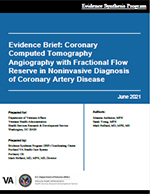
Prepared by:
Evidence Synthesis Program (ESP) Coordinating Center
Portland VA Health Care System
Portland, OR
Mark Helfand, MD, MPH, MS, Director
Recommended Citation:
Anderson J, Young S, Helfand M. Evidence Brief: Coronary Computed Tomography Angiography with Fractional Flow Reserve in Noninvasive Diagnosis of Coronary Artery Disease. Washington, DC: Evidence Synthesis Program, Health Services Research and Development Service, Office of Research and Development, Department of Veterans Affairs. VA ESP Project #09-199; 2021.
Download PDF: Brief, Supplemental Materials
The impact of regularly utilizing HeartFlow for all patients referred for CCTA within the VA is likely low but use of HeartFlow in facilities that regularly utilize CCTA and in specific clinical scenarios could potentially reduce unnecessary use of invasive coronary angiography (ICA). Research in VA settings and comparing HeartFlow to specific noninvasive strategies is needed to determine the potential impact of HeartFlow within the VA.
Coronary computed tomography angiography (CCTA) has good diagnostic accuracy for identifying obstructive coronary artery disease (CAD), but it cannot assess the functional significance of coronary artery narrowing. Fractional flow reserve (FFR) measured invasively is considered the gold standard for detecting functionally significant CAD. HeartFlow uses computer modeling to noninvasively estimate FFR from CCTA images. In 2019, the ESP synthesized the evidence on the use of HeartFlow for the diagnosis of CAD and identified important gaps in the evidence.
This updated synthesis included 24 studies on HeartFlow use in patients with suspected CAD. New evidence agreed with the previous finding that HeartFlow likely has good diagnostic accuracy for identifying obstructive CAD. No new evidence examined HeartFlow use in patients directly referred to ICA or as a substitute for other noninvasive testing. New evidence comparing ICA use in patients undergoing CCTA alone or HeartFlow had severe methodological limitations. New evidence agreed with the previous finding that short-term rates of cardiac events are similar in those receiving HeartFlow and those receiving other diagnostic strategies, but research on longer-term clinical outcomes is needed. CCTA use within the VA remains relatively low and is unlikely to change without direct evidence that a CCTA-based strategy is preferable to other noninvasive strategies. Controlled studies of ICA rates in patients with suspected coronary disease receiving CCTA or other noninvasive strategies and comparing HeartFlow to specific noninvasive strategies are needed.
Evidence Brief: Coronary Computed Tomography Angiography with Fractional Flow Reserve in Non-invasive Diagnosis of Coronary Artery Disease (Management eBrief)